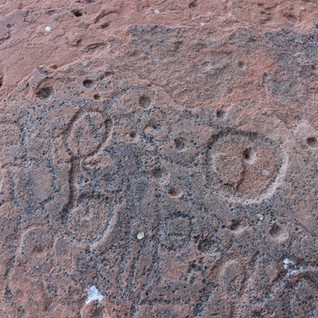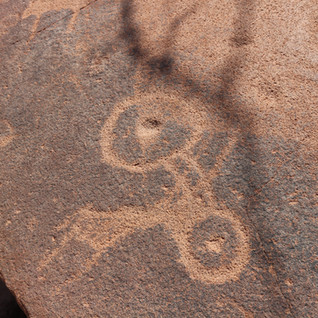Craig Kraft

Finding Hope
Neon
12”x24”x3”
Hope is sometimes obscured in our culture. When it can be found and experienced, it is transformational. In this project I will site the word “Hope” in neon around the D.C. area. It will be installed in unlikely places, with the neon glow facing away from the viewer, and onto the building’s structure. The glow from the hidden source pulls the viewer to look more closely, at which point, they can see the word “Hope” in a soft white glow of neon. The project is titled “Finding Hope.” I will make it a public interest project as sites are discovered and reported back to the studio, finally being announced on social media.
Knotted Gun

Neon, wood, acrylic paint
16”x20”x3”
To take the guns away from the citizens and the police – like England does.
Missing Persons Flyers

I saw a news special on missing indigenous persons in the Southwest and how they are ignored. I realized that missing persons happen everywhere, including right in my backyard in Southeast DC. Having used neon in my artwork for 35 years, I thought of a new use: Emergency Neon to use the power of neon to draw attention to the issue. These neonized missing person flyers are available for public use.
NBC 4 Nightly News in Washington D.C. ran a story about the Emergency Neon project.
The Damaged Spirit of the African Elephant

Neon, Wooden Mount, Transformer
5' x 6' x 4'
On a trip to Namibia, I discovered the Sans, arguably the oldest indigenous people in the world, the rock art they created, and the wild animals that inspired it. The Sans believed animals were portals into the spiritual world, and when they put paint to rock, the animal’s essence was harnessed, opening the spirit portals. This work is my attempt to capture the spirit of the African elephant, which is both tangible and intangible, elusive but recognizable. The piece is an 11ft x 8ft installation generated by 75 neon tubes made from vertical segments spaced 1.5 inches apart. The red markings on the majestic elephant’s tusks represent the horrific poaching in Africa, which has damaged the African elephant’s spirit.
Ground Zero Series
The Ground Zero Series is inspired by years of unrelated, overlapping graffiti on the walls of Ground Zero Blues Club in Clarksdale Mississippi. The entire club is covered including, for example, lampshades, all of the woodwork, the felt on the pool table, and each slat on the window blinds. The years of overlapping graffiti tell stories of love, hate, exuberance and joy. Each mark is subject to an overlapping mark, until the messages become blurred and confused, only until someone makes an even bolder, broader mark, obscuring the history below. Finally, I make my own light mark, transforming and reinventing the images.
After transforming my own random scribbles into neon drawings in the series “Unintentional Drawings” I noticed a photograph in (the NY Times) of the Ground Zero Blues Club taken by Shane Lavelette for the High Museum in Atlanta. It was for an exhibition titled “Picturing the South”, 2010. The image of a corner of the club immediately resonated, reminding me of my own random graffiti. Yet it was different; it was done by strangers in a dark classic southern blues club. There were decades of mostly intentional, overlapping marks entirely covering the club.
In February of 2013, I traveled to Clarksdale Mississippi to see the graffiti, first hand. The visual impact was astonishing. The feeling was similar to when I discovered my unintentional drawings years before. I stayed for two days in Clarksdale collaborating with photographer Evy Mages taking thousands of images of the club walls, ceilings and furnishings. They were all taken in low light and hand held. I selected the most poignant images, knowing I was going to light them and had them printed on 3’x2′ Epson premium photo paper-enhanced matte. Painted and scratched neon tubing was then used to highlight, deconstruct and reinvent the original images.
Random Neons
This artistic process was inspired by the random selection method originally developed by John Cage in the 50's. Tubes were selected randomly from my 25 year old collection of rejected, collected and donated neon tubes. They were then placed onto steel tubing and mesh structures without regard to composition. This method results in a colorful, spontaneous and arresting light sculpture.
Unintentional Drawings
I had an epiphany when I rediscovered a series of doodles or scribbles that I had been creating all my artistic life. These doodles were folded away in drawers on scraps of paper, newspapers, and other project folders. They hung in my closet directly on the pant legs of my jeans. Created while concentrating on something else, the drawings flowed unconsciously and uncontrollably from my hands to the closest writing surface. Characterized by freshness and fluidity and wrought with implied meanings, they were created without preconceived notions or intent to exhibit. I consider them to be “found objects” not unlike the cave paintings that the surrealist artist Brassaï photographed and then titled Unintentional Poetry in the 1930s. The doodles draw attention to the small voices within us, the nuances of the mind that mostly go ignored or unrecognized. I took these doodles, increased their scale, drew patterns from them, and transformed them into neon drawings. Almost incidentally, I decided to show the reverse side of these works that reveals the mechanics of the pieces. They are run by over 30 transformers, generating 270,000 volts of electricity. The power of neon transforms the forgotten into the remembered. The Unintentional Drawings are no longer small and insignificant; they now stand on their own as momentous and meaningful. I am reminded of Brassaï's observation that “beauty is not the goal of art, but its reward.”
Cave Symbols

Painted Canvas, Neon, Transformer 48 x 45 x 4"

Painted Canvas, Neon, Transformer 48 x 45 x 4"

Neon, Rock, Paint, Charcoal

Painted Canvas, Neon, Transformer 48 x 45 x 4"
I was particularly drawn to what are referred to as "signs" or symbols which may be the earliest known marks of all. Previously, researchers and artists had concentrated on the pictorials, figurative drawings and paintings of mostly animals, ones that were hunted and those who were most feared. The "signs" translate into contemporary abstract image making partially because they have a universal quality. Starting with the line, they progress through dots, cubes, penninforms (drawn here), ovals, claviforms and finally the vulva. These marks, made by the flickering light of a fat lamp appear to be moving in the caves. What I have drawn here is inspired by my experience in the caves - in this case penninforms drawn with charcoal and pigments found in the Niaux cave. I have lit the drawing with a flickering light, in a similar way early Homo Sapiens drew deep in the ancient caves.
I went specifically to view, first hand, drawings made by early Homo Sapiens from approximately 40,000 BP, the very oldest marks to date. This trip is the next step in my inquiry into the universal human urge to mark - from ancient time through contemporary art making. The trip was strenuous: six days of hiking through rice patties, over uneven, rough ground, ending in 10-50' rock climbs up the mountains to explore the ancient caves. It was a profound experience and it has already reorganized my conceptual approach to mark making.
Considering the literature, my own direct experience with ancient drawing and painting, my Unintentional Drawings, the Ground Zero graffiti and my Cave Drawings, it has become clear to me that the universal urge to mark is actually a universal urge to connect, through mark-making, to something deep within us, possibly to a higher power or spiritual world outside of ourselves. The universality is strongly suggested by the fact that over 40,000 years ago Homo Sapiens evolved out of Africa and migrated to both Europe and Asia and arrived to make the same symbol: the hand stencil.
Namibia, Africa












Sulawesi, Indonesia















Lascaux, France




Column Interrupted
Metaphorically and literally, light has a way of leading from one state or phase to another. In many ways it is about transitions, the in between. Column Interrupted captures this unique functionality of light. The light dissolves the physicality of the different sized aluminum columns and melds them into a continuous one.
Bound Diver
Created in 1996, Bound Diver is the result of a collaboration between Bonnie Bernau and Artist, Craig Kraft. Bernau approached Kraft while she was in treatment for stage 3 breast cancer, undergoing chemo and preparing for bilateral mastectomy. She was drawn to the artistic process of body casting as a way of natural healing. After 6 months of chemo and before her surgery, Kraft cast Bonnie’s body in a diving pose and lit the cast with hidden neon tubes on the edge, which was hung by a rope from above. This resulted in a holographic style image of Bonnie as a bound diver.
Her bound figure was symbolic of her struggle with a dangerous disease, contrasted by her embodiment as a diver, expressing her strength and creative spirit. At a certain point, as the chemo became more challenging than the disease, Bonnie chose to address her cancer with acupuncture, yoga, and a macrobiotic diet. Combined with the artistic body casting experience, she healed holistically and has been free of cancer since 1996, making a strong case for art as a natural healer. “Bound Diver” is a part of the permanent collection and is currently on view at the Museum of Neon Art in Los Angeles, California.
Climate Change
Climate Change is undeniably the most urgent international issue of our time. This piece utilizes alternating flashes of lightning and tornadoes combined with swirling storm debris to capture the violence of increasing superstorms caused by inattention and slow response to climate change worldwide.
"Environmental degradation is the theme of the Honfleur show’s most complex offering, “Climate Change.” The artist piled and mounted metal and wood storm debris, which is backlighted in pink and blue, and punctuated by three lightning bolts: jagged white-colored tubes with red-glowing ones coiled around them. The white light travels down the vertical tubing like electricity crackling from sky to earth, endowing the installation with movement and a hint of menace. If most of “Emergency Neon’s” pieces are simple placards written in neon, “Climate Change” is a multi-act drama."
- Mark Jenkins, Washington Post











